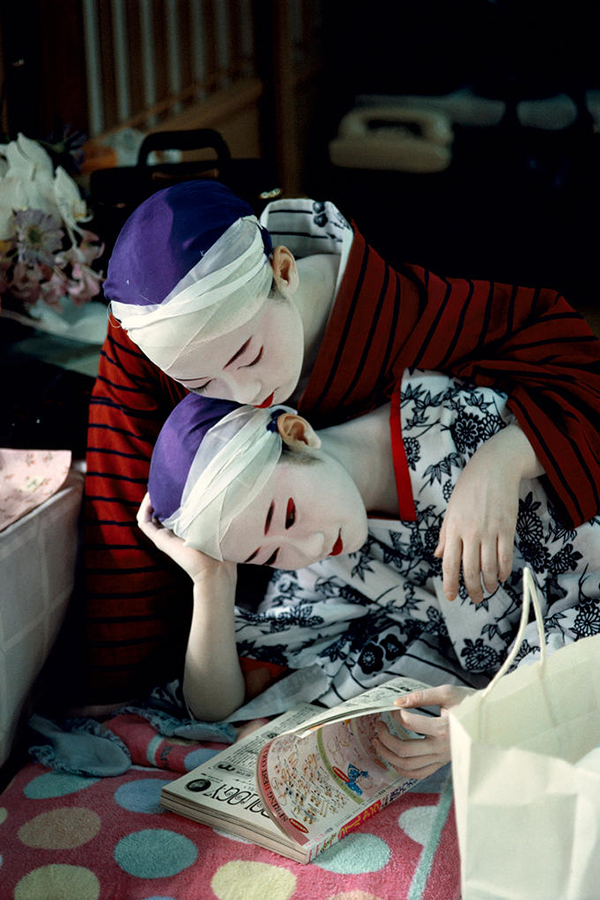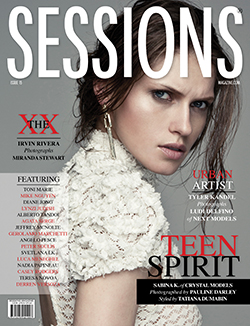I came across this interview today and I found it really interesting. Jodi Cobb is a freelance photographer for National Geographic, and she has had a pretty inspiring career. It’s not fashion photography, but every photographer appreciates what a documentarian can accomplish.
This interview is from Photo.net, I did not write it. You can see the original interview here: Photo.net
Enjoy!
–
by Hannah Thiem, March 2009 (updated February 2011)
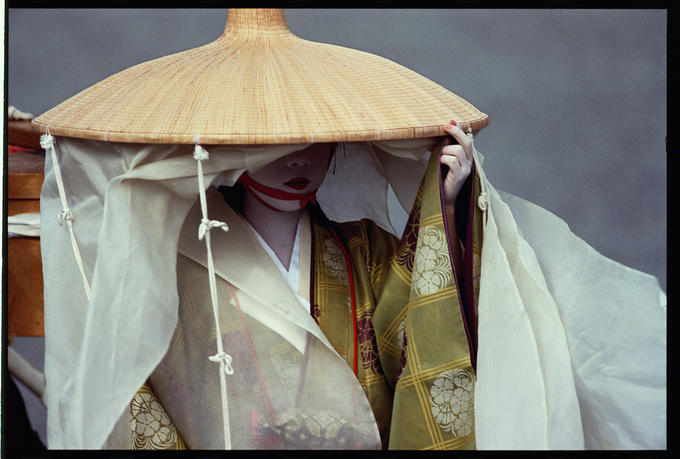
Tell us a little about your time shooting for National Geographic.
I’ve been a staff photographer at National Geographic for several decades. Prior to that, I had worked as a staff photographer for two newspapers for a short time right out of school, then went to Geographic and I’ve been there ever since. I had been on staff until last year. They’ve eliminated the position of staff field photographers at National Geographic to switch to an all freelance photography department.
How does that change the relationship with National Geographic, moving from staff to freelance?
It’s very exciting for me. It was time. I’ve been there my whole life. I always talked about being on my own and doing other things, and now I can. When I left, it was a great time. Now, with the economy, it’s a little harder. It’s been pretty tragic since then. Who knows what’s going to happen with the photography business, especially with documentary/investigative journalism photography. I’m still doing work with them. I just finished an assignment on Venice, which was my first major assignment shot entirely in digital. We just finished the layout last week.
National Geographic has been the pinnacle for so long for photojournalists, documentary photographers, and science photographers. How long do you see that lasting? Do you think National Geographic will be able to survive the digital and online media push?
I don’t know. No one knows the answer. The more I’ve had time to think about my next move, the more I realize how much I love to photograph. I just love taking pictures. While there are other things I could do such as editing, there’s nothing like taking photographs for me, and I’ll be happy as long as I can keep doing that. The final medium doesn’t matter as much anymore. I used to think that you had to have a magazine in your hand. Currently, there are all sorts of ways of looking at photographs and I think that if photographers don’t embrace all that, we’re lost.
I’m one of the last converts to digital. Now that I have, the advantages of digital for me have been huge. It’s really renewed my enthusiasm for photography. Usually on a project, I’m in the field for a month or more at a time and unable to see any pictures that I’ve taken. To be able to see the pictures is huge. Before, I had to just rely on faith that the camera was working and that my settings were correct.
I never was that interested in equipment and technology until went freelance and switched to digital. I’ve always just used whatever I could to interpret what I wanted to show. The kinds of photography I was doing in small places, small rooms, and intimate spaces, I didn’t enjoy using flash. It was so intrusive, disrupting, and I never really learned to master flash technique. Now, I can see in the dark with digital. I like to think I waited to switch to digital until they’ve optimized all the equipment, and I was able to jump in at the end of the digital revolution [she laughed].
What is your typical lens kit these days? Have you had any major focal length changes over your career?
I find all the Nikon zooms with VR (vibration reduction) to be pretty cool. I’m using the same focal lengths, but instead of having to use five prime lenses, I have two zooms, which has simplified my life enormously. I do a lot of wide angle and moderate telephoto work, and occasionally will use a 300 or 400mm on very special things, such as the “21st-Century Slaves” story for long shots down streets where I was not supposed to be.
Can you relate a quick synopsis of how you broke into this field of work, specifically the larger format photojournalist story telling?
Our choices were much fewer when I was starting out. Fine art photography back then didn’t exist as a concept. It wasn’t appreciated as much as it is now. Only a few magazines existed for this line of photography: Life, Look, and National Geographic. Then Life and Look folded. National Geographic, Time, and Sports Illustrated, and newspapers were all that existed for a time. That has changed so much and so fast over the years. There are just so many venues and opportunities now for photographers, if you move away from the printed medium. You see newspapers dropping like flies, magazines folding or getting rid of their staff photographers. I don’t know what to tell you on the photography career path right now. It’s kind of scary in the documentary/news photography line of work to get paid for being a photographer. There are all kinds of outlets now online, but to have someone to support your work, that’s one of my biggest fears with all the newspapers folding—who’s going to pay investigative journalists? Can the people who do the work make a living?
What were some real turning points in your career?
- In college, Cornell Capa who started the International Center of Photography, came out and saw my work, gave me a grant and got me exhibitions in New York. That was the start of a great relationship and got me onto a certain level of being seen or known.
- Getting a summer internship at a newspaper and staying on there.
- Being laid off at the Denver Post and having the Director of Photography atNational Geographic call me the next day with an assignment. That was the major turning point, and probably the last big one.
- A grant from Kodak to do the Geisha book.
- Moving to freelance.
With so many outlets going down, disappearing, or changing, does grant work come into play in your career? When you mentioned Kodak, though, as a previous grantor, it’s apparent a lot of companies that you normally might have been able to approach for grants to support your work are fighting their own battles to survive.
That was something I was going to start looking into to support my freelance work. The kind of photography I want to continue doing is very much about human rights issues and “changing the world.” I was thinking that grants were going to be a way forward, but who knows about that.
Can you take a moment to describe what you enjoyed about working with National Geographic? What doors do you see opening for you now that you’re freelance, and what challenges do you face?
I really love the kind of work that shines a light on human rights issues. It started with the story I did on 21st-Century Slaves, and then I did the story on “Love”, which turned into Love & Marriage as a human rights issue around the world. I’m very interested in the conditions of women around the world and in some way helping to empower women in countries where they’re not empowered. National Geographic has always been a great medium to do that because of its reach. Currently, they also publish 32 language editions so the reach is all over the world, much more than it used to be. I know they still want those kinds of pictures and I fully intend to continue working with them on that.
I want to see what other kinds of outlets for this type of work there are. It’s just been so crazy lately. My wonderful assistant and I have been getting everything organized to set up my business at home—getting new computers and equipment, monitors and printers. Setting up a business at home. All these things I used to have readily available at National Geographic, but I now have to take care of myself.
Photographers of the current generation don’t experience a male/female split. Was that a struggle for you when you were starting out?
When I got into the business, women in all sorts of fields and professions were finding themselves as the only women or first women in the business. I didn’t think about it in the beginning—I didn’t know that photography was considered a male profession. I just thought, “I can do this, this is wonderful,” and just plunged ahead. I was always the only women every place I worked on staff. I would be asked to do something and I would be glad to feel accepted at last. Then I would hear, “Well, we do need a woman on this panel because it’s all men, we need a woman.” It would be a slap in the head again. Which is it, you need a woman, or you like my photography? There was always that doubt because you were reminded constantly of it. Now it’s a non-issue.
Did you feel like that came from above? Were you fully accepted by your colleagues?
I had nothing but support from my colleagues. I think that photography is a really unique profession in the willingness that photographers have to share information and camaraderie. That’s been huge from day one and what I loved so much about the business. In the darkroom at the newsroom, the other photographers were fabulous helping me along. It’s been that way my whole career.
In the field, however, I sometimes was not taken seriously, especially in very male-dominated cultures. For example, I requested permission to photograph a king and the reaction was, “where’s your photographer?” Me! It was a struggle quite often. I’ve chosen to never dwell on it, for therein lies madness. You just do the best you can, and people are either going to accept it or not.
Are you currently serving in some sort of mentor capacity to younger aspiring female photographers?
Not in any sort of organized way. It’s more informal. I get emails from young women all the time. Also, many successful women have come up to me and said, “I met you at a workshop and you said this and that, you inspired me.” My reaction to that is “Oh, thank goodness.”
I wanted to get some background on how you’ve worked in the past and currently on some of your stories, especially the “Geisha” project. What is your process from start to finish? What’s your process for completing the project?
Early on, it was really hard to get a story idea through at Geographic. I took assignments they gave me for the first decade or so. As the only woman on staff, I also felt the need to prove that I could do anything the guys did. I didn’t really specialize early on, I just tried to do everything—sports, adventure, outdoors, landscape, people. When it seemed like the guys were starting to specialize in things, I thought, now I can specialize too. I’ve proven I can do all these other things, and now I started proposing concept stories, like “Beauty” and “Love” and “Slavery.” They were all my ideas.
Could you walk us through the “21st-Century Slaves” story?
That was my idea. I read a small thing in the newspaper about the passage of the Anti-trafficking Act. I started asking people what they knew about trafficking and slavery and nobody really knew very much at all. That inspired me to look into this issue further. I proposed the story, thinking it probably wasn’t the kind of topicNational Geographic would do. To my surprise, they accepted it. I felt quite overwhelmed at that point, realizing I had no idea how I was going to do this. I started researching, placing one foot in front of the other. One thing leads to another and you start finding the people who are going to help you. You do your research and find the people who know the subject. I went to all these NGOs and conferences on slavery, I found anti-slavery groups that were helpful.
Then I sat down with the Illustrations Editor, Susan Welchman. Every story at National Geographic has an Illustrations Editor who shepherds the whole story through from the concept to the budget to the story plan, locations, length of time, how much you’re going to spend. We then planned what kinds of slavery and trafficking I was going to cover in this story. They wanted a broad look at all kinds of slavery and trafficking. I researched where I could get the most access for each kind of slavery and laid out a master plan of 10 countries I wanted to go to: the internal trafficking of children in Benin and Ghana in Africa; child labor in India; sex trafficking in Thailand, Israel, Mexico, Italy, and the US; illegal adoption in Guatemala. The legends writer and researcher are assigned to the story right at the beginning of the project.
Halfway through, we showed the pictures and the story thus far to the editor and the team, and they were really impressed at what we had been actually able to get, to see and shoot. They gave us the go-ahead to finish the story.
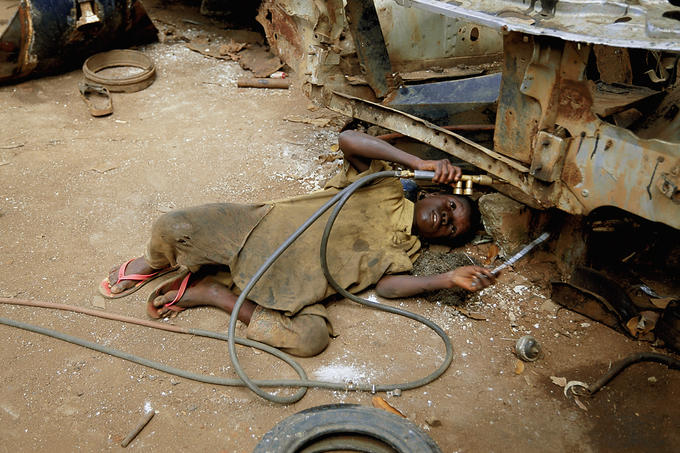
How many projects get stopped at that point?
Not very many. They have a good idea of what’s doable and what’s not and they tend to use photographers with a proven track record. It’s a very small proportion that get cut. Sometimes the photographer will say, “We just can’t do this,” for whatever reason. Also, at the halfway point, you can also completely revise your idea. If the entire story proved impossible to actually get photographic evidence of what was going on, maybe we would have just turned to child labor or to something else.
And then how do you bring a project to completion?
You complete the second half and show the final photographs to the editor and everyone else. It has to receive the final stamp of approval. Then, everything starts to come together in the office—the layout, the captions (legends), maps, charts, photographs. the research. I can’t tell you how grateful I was for the incredible research staff that National Geographichas, and to be able to tap into it on that story. Slavery really hadn’t been done before in a sort of global overall look and I was terrified that I had gotten it wrong. If this is so big and pervasive, why was I the first one to try to be photographing this? I almost wept with gratitude when the research department came back and confirmed that what I had found was all true.
What kind of time frame did you have to work with all of that?
I always come in under budget on these stories. We were very careful in targeting and very lucky in the quality of the help I had on the ground in the places we went to. All the research and arrangements we were able to make in advance meant I could hit the ground running—I could spend three days in Israel and find myself in a brothel in Tel Aviv shooting the story immediately and out in 3-4 days. It was that kind of advanced planning and setting up that really made the project possible. There had been previous stories out there on just sex trafficking, child labor, or illegal adoptions. No one had the budget to do the entire issue of trafficking in a huge global way—only Geographic had the budget to do a story that all-encompassing.
The entire spread ended up being about how long? That’s a very broad topic to cover.
The final story ended up being 26 or 28 pages, which was a lot at that time, and is a lot now. Just one picture was featured on each of the different aspects of trafficking. The project got the biggest response in the history of National Geographic up to that point. This was just unbelievably gratifying to me. The overwhelming response wasn’t just people writing in congratulating us on the story, it was people sending money to the organizations combating trafficking, FBIagents asking to be trained in trafficking issues, (which was one of the issues in this country, that they didn’t recognize trafficking for what it was, they just looked at it as prostitution or immigration issues. Law enforcement didn’t really know how to deal with the issue of sex trafficking. Now, FBI agents have been trained in that issue.) The publication of the story actually instigated changes—and you can’t ask for more than that.
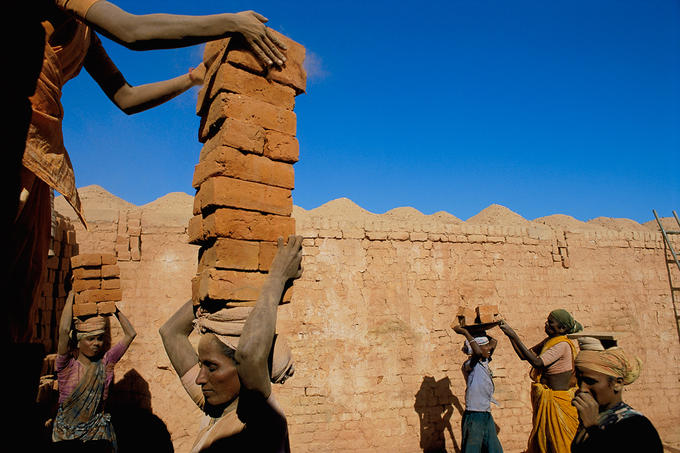
What work of yours are you most proud of, either because of a personal triumph, the physical success of the project, or you just really liked the images that came out of the project?
Almost every project up until then has been astounding for different of reasons. The “Geisha” project was my favorite to do. It was something I did on my own outside of National Geographic. It felt wonderful that I was able to do something like that all by myself—organize everything, get the publisher, write it, organize the editing and layout—everything from beginning to end. That was huge for me, especially given the fact that it had never been done before, that nobody had ever photographed extensively inside the Geisha world before. I had no idea when I started if I could do it—if there was any way a geisha was going to let me inside a geisha house. At the end, the project was very gratifying to me and so beautiful to photograph. I want my photographs to either be beautiful or meaningful—and hopefully both. This project was a combination of both. Mainly, it was just a pleasure to shoot and look and to be there. I love writing, so it was also a chance to prove I could write.
About half the time, it seems that the photographer and writer run in separate circles and about half the time, they’re in the same foxhole. Does that depend on the story?
It depends on the story. If it’s an adventure trek and the writer and photographer are together, they’re going to be having the same experiences. On all stories, the photographers and writers meet in the beginning and really hash out what direction they want to take, what their point of view is about the topic, and find out if they’re on the same page on the point of view, and making sure they going to end up at the same destination even if they go different routes. They’re completely different disciplines: photography and writing. A photographer often doesn’t like waiting around with the writer interviewing the Minister of Information, and the writers really hate sitting in the car with no one to talk to while the photographer waits for the beautiful light and the camel to walk by. They can really get on each other’s nerves if they’re trying to accommodate each other on an every day, all-day basis. Writers don’t usually have as much time in the field as the photographers do. By necessity, the positions are not hand-in-hand.
What kind of mode do you go into when you’re in the middle of a project? How do you feel when you know you’re onto something and following the leads that keep coming?
It’s very exciting. You feel really good on an intellectual basis—that you’re nailing the story and heading in the right direction. For most photographers, when they really love what they’re shooting and into the photographs, they’re in the zone and it’s a zen thing. Nothing else exists. You’re in your groove. I’ve talked to other people like figure skaters, athletes, writers, people who love what they’re doing and it’s so intense. That’s the joy and the payoff for them—to be completely engrossed in that incredible creative zone. That’s what’s fun. Of course, it ebbs and flows. The next day, you couldn’t shoot your way out of a paper bag. Nothing goes right, the people don’t show up, all your reflexes are off, and you’re missing every picture.
What’s not fun about your job? Even great jobs have aspects that aren’t wonderful. National Geographic is a highly idealized job.
The things that photographers go through to get those pictures are really incredible. If you get a group of photographers together and start telling war stories, you just can’t believe what you’re hearing. Some of the projects have been dangerous physically, stressful mentally, and you’re off by yourself for weeks or months at a time with no friends, no time off, no way to escape the project. It really has downsides. Your personal life really takes a hit. I didn’t know how hard it was going to be when I started out. When I realized how hard it was I thought of just doing this for five years and then move on. But, the opportunities just kept getting better and better—offers to cover more interesting stories, go to more interesting places—and soon a lifetime went by!
What is your process for gaining people’s trust, either before while starting out a project, or when you’re in the middle of the project, how do you get to the core of what you’re going after?
I’m always completely upfront with everyone about what I’m doing, what I’m looking for, and what I’m going to do with the pictures. I try to engage them in the process—to become interested and invested in it too. Then I enjoy the people. In terms of long projects, like the “Geisha” project, you just show up every day, and you try to befriend one person and ask them if you can photograph their friends. For a lot of projects, I just take it one person day by day. It’s just who you are and the way you approach people and relate to them that enables you to gain strangers’ trust.
Have you had any of the people write to you, follow your stories, or request copies of the photographs?
Usually, I get the names and addresses of everyone that I photograph in any real extensive way. if we use their picture inGeographic, they get copies of the magazine. For the rest, since I photograph so many people, I tell them at the beginning that I can’t give them copies. I don’t have enough time or resources to send them pictures. I’ve stayed in touch with a lot of people.
You’ve talked about 21st-Century Slaves as an example of one of the largest you’ve worked on through the magazine. How does what you’ve learned from working with National Geographic on the large projects translate to your average small-town photographer who wants a project to call theirs?
There are stories everywhere—in your own house, your backyard, your town. You need to find out what you’re interested in, what you’re passionate about, what you want to change, celebrate, illuminate, interpret. It’s right there. You just need to get started. Once you do, things start falling into place, after you’ve made the first introductions or the first start on the project. If it’s going really well and you feel you’re onto something or doing a beautiful job interpreting what it is you love, you can take that beginning to someone to get funding. You can say, “This is what I’ve done, I want to continue this in a global way or in another country, but I can’t do it on my own.” Rarely will an editor just take a chance on someone and just offer a project out of the blue, without some kind of demonstration of your abilities to execute the idea. I know a lot of projects at National Geographic that started that way. People came in with an idea that they started and then they’ve gotten funding to finish it.
